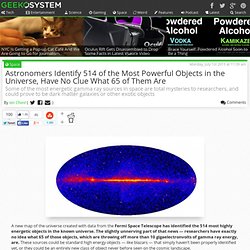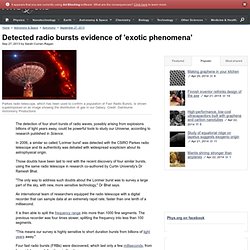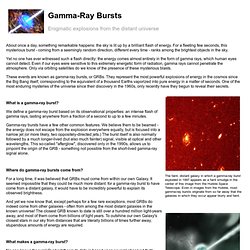

This Distant Galaxy Appeared Just 400 Million Years After the Big Bang. There's a Giant Hole in the Universe. Our Best View Yet of the Galaxy’s Massive Electromagnetic Loop. Gravitational Lens Creates A Perfect Einstein Ring Across The Universe. We Got to See This Supernova Explode Four Times Simultaneously. This is the most detailed map yet of our place in the universe. Mysterious signal from the center of the Perseus C... - The Watchers. Astronomers using NASA's Chandra X-ray Observatory to explore the Perseus Cluster, a swarm of galaxies approximately 250 million light years from Earth, have observed the spectral line that appears not to come from any known type of matter.

The signal they received can not be explained by known physics but they say it shifts suspicion to the dark matter. Perseus Cluster a collection of galaxies and one of the most massive known objects in the Universe, immersed in an enormous 'atmosphere' of superheated plasma. It is approximately 768 000 light years across. Perseus Cluster. Image credit: Credit: NASA / Chandra "I couldn't believe my eyes," says Esra Bulbul of the Harvard Center for Astrophysics.
"The cluster's atmosphere is full of ions such as Fe XXV, Si XIV, and S XV. Yet, in 2012 when Bulbul added together 17 day's worth of Chandra data, a new line popped up where no line should be. The spectral line appears not to come from any known type of matter. In short, it appears to be real. Neutron Stars Tear Each Other To Shreds, Black Hole Ensues. The Anomalous X-Ray Arms of the Galaxy Known as NGC 4258. Astronomers Discover the "Mega Earth," an Entirely New Type of Planet.
Most Amazing Exoplanets. The term ‘exoplanet’ applies to any planet outside of our solar system.

At last count, we have identified 3,538. Out of the thousands of planets we know about, some of them are incredibly bizarre compared to what we are used to seeing in our own solar system. Here are some exoplanets with very unique characteristics: Kepler-78b The most astounding fact about Kepler-78b is that it shouldn’t even exist, according to our current knowledge of planetary formation. The planet itself is only slightly larger than Earth, though surface conditions are markedly different. WASP-12b While Kepler-78b still has about 3 billion more years before getting consumed by its star, the process is well underway for WASP-12b. The planet is described as a “hot Jupiter” as it is a gas planet that is about 40 percent larger than Jupiter.
Could This Be The Signal Of Dark Matter? Unsure Scientists Checking This Out. Want to stay on top of all the space news?

Follow @universetoday on Twitter Sometimes a strange signal comes from the dark and it takes a while to figure out what that signal means. In this case, scientists analyzing high-energy gamma rays emanating from the galaxy’s center found an unexplained source of emission that they say is “consistent with some forms of dark matter.” The data came courtesy of NASA’s Fermi Gamma-ray Space Telescope and was analyzed by a group of independent scientists.
They found that by removing all known sources of gamma rays, they were left with gamma-ray emissions that so far, they cannot explain. Scientists aren’t even sure what dark matter (which can only be detected through gravitational effects) is made of. Astronomers directly image a filament of the “cosmic web” for the first time. Astronomers have long predicted that a “web” exists that is primarily composed of dark matter and could give clues about the overall structure of the Universe.

Researchers were able to use light from an ancient quasar to image the hydrogen gas from a filament of the cosmic web for the first time. The study was led by Sebastiano Cantalupo of University of California at Santa Cruz and was published in Nature. The web is predicted to be a net-like arrangement, up to 84% of which is believed to be dark matter which cannot be seen. Galaxies are not found sporadically in the Universe; they are arranged into clusters and super clusters which connect to form filaments in the web due to gravity. New study dramatically changes where we believe aliens might live.
65 High Energy Gamma Ray Sources Still Unidentified. A new map of the universe created with data from the Fermi Space Telescope has identified the 514 most highly energetic objects in the known universe.

The slightly unnerving part of that news — researchers have exactly no idea what 65 of those objects, which are throwing off more than 10 gigaelectronvolts of gamma ray energy, are. These sources could be standard high energy objects — like blazars — that simply haven’t been properly identified yet, or they could be an entirely new class of object never before seen on the cosmic landscape.
One explanation for the unidentified energy sources — which throw off huge amounts of gamma rays, but are not associated with radio or optical emissions, could be dwarf galaxies composed of dark matter. If that’s the case, learning more about these mystery objects could help us understand dark matter more thoroughly. Mystery Intergalactic Radio Bursts Detected.
Astronomers were on a celestial fishing expedition for pulsing neutron stars and other radio bursts when they found something unexpected in archived sky sweeps conducted by the Parkes radio telescope in New South Wales, Australia.

The powerful signal, which lasted for just milliseconds, could have been a fluke, but then the team found three more equally energetic transient flashes all far removed from the galactic plane and coming from different points in the sky. Analysis later indicated that, unlike most cosmic radio signals that originate in the Milky Way or a nearby neighbor galaxy, these four seem to have come from beyond. PHOTOS: Cosmic Hotshots from Keck Observatory Whatever triggered the bursts has come and gone. The signals, detected between February 2011 and January 2012, were one-time events so little follow-up work can be done.
Detected radio bursts evidence of 'exotic phenomena' The detection of four short bursts of radio waves, possibly arising from explosions billions of light years away, could be powerful tools to study our Universe, according to research published in Science.

In 2006, a similar so called 'Lorimer burst' was detected with the CSIRO Parkes radio telescope and its authenticity was debated with widespread scepticism about its astrophysical origin. Those doubts have been laid to rest with the recent discovery of four similar bursts, using the same radio telescope in research co-authored by Curtin University's Dr Ramesh Bhat. "The only way to address such doubts about the Lorimer burst was to survey a large part of the sky, with new, more sensitive technology," Dr Bhat says. An international team of researchers equipped the radio telescope with a digital recorder that can sample data at an extremely rapid rate, faster than one tenth of a millisecond. It is then able to split the frequency range into more than 1000 fine segments. Gamma-Ray Bursts. About once a day, something remarkable happens: the sky is lit up by a brilliant flash of energy.

For a fleeting few seconds, this mysterious burst - coming from a seemingly random direction, different every time - ranks among the brightest objects in the sky. Yet no one has ever witnessed such a flash directly: the energy comes almost entirely in the form of gamma rays, which human eyes cannot detect. Even if our eyes were sensitive to this extremely energetic form of radiation, gamma rays cannot penetrate the atmosphere. The Strongest Electrical Current in the Universe Spotted, 2 Billion Light Years From Here.
NASA has found a free particle accelerator floating in space. Rogue planets can form without a parent star. Astronomers may have just discovered the first known free-floating planet. There isn't any reason this object wouldn't or couldn't have satellites of its own; and probably does.

Earth has 1-6 moons at any given time, but we don't really notice them because they're small and interloping. Here, experiment: Sadly there is no way to intelligently answer those questions at this time beyond "Well, we do not know of any reason either of those things should be impossible, but we do not know anything about what would make that possible either. " We simply have no empirical evidence to work with here except for what we can observe in our own solar system, and we have absolutely no way to know whether what we observe here could be considered "typical" or whether our system represents some extreme abberration... or even whether the interactions which govern stellar/planetary formation allow for the word "typical" to have any meaning whatsoever.
So what you're saying is "Maybe, maybe not"? Wait, 1 to 6 moons? Hot Jupiters are the most astounding planets in the galaxy. Unprecedented: Amateur astronomers discover a planet with four suns. False.

Hubble has spotted an ancient galaxy that shouldn't exist. Mysterious Cosmic 'Dark Flow' Tracked Deeper into Universe. Mysterious Cosmic 'Dark Flow' Tracked Deeper into Universe Distant galaxy clusters mysteriously stream at a million miles per hour along a path roughly centered on the southern constellations Centaurus and Hydra. A new study led by Alexander Kashlinsky at NASA's Goddard Space Flight Center in Greenbelt, Md., tracks this collective motion -- dubbed the "dark flow" -- to twice the distance originally reported.
"This is not something we set out to find, but we cannot make it go away," Kashlinsky said. "Now we see that it persists to much greater distances -- as far as 2.5 billion light-years away. " Why did all the planet-forming dust around this star disappear in only three years? If giants are common in inner solar systems (they seem to be), then its possible a gas giant or even a system of gas giants collected the material... Its also possible that there's an eccentrically orbiting giant that wildly varies its distance from the parent star, which would allow it to sweep up large amounts of material on the inbound/outbound trajectories without creating too much wobble that we'd notice with limited observations. Of course, something else could have collected the dust and material. We could have just seen the "billion-billion to one" shot of watching an advanced interstellar species mine a lifeless system for material.
Or if it turns out that the system has rocky inner planets, we may have just seen a species prep a star system for eventual terraforming and colonization. Ten of the Most Interesting Structures of the Universe - From Quarks to Quasars. To quote the late Douglas Adams (the beloved author of “The Hitckhikers Guide to the Galaxy” books): “Space is big. You just won’t believe how vastly, hugely, mind- bogglingly big it is. I mean, you may think it’s a long way down the road to the chemist’s, but that’s just peanuts to space.” Truer words have never been spoken, as the universe itself is so big, it is incomprehensible, even to the most knowledgeable and open minded individuals.
With a diameter that extends more than 93 billion light-years across, many very large objects are just lurking out in space, waiting to be found. Fermi at Five Years. Astronomers Discover the Most Massive Structure in the Universe. What the heck is this strange red rectangle doing in our galaxy? How alcohol is formed naturally in space. The quantum secret to alcohol reactions in space. Public release date: 30-Jun-2013 [ Print | E-mail Share ] [ Close Window ] Contact: Sarah ReedS.J.Reed@leeds.ac.uk 44-011-334-34196University of Leeds Chemists have discovered that an 'impossible' reaction at cold temperatures actually occurs with vigour, which could change our understanding of how alcohols are formed and destroyed in space.
To explain the impossible, the researchers propose that a quantum mechanical phenomenon, known as 'quantum tunnelling', is revving up the chemical reaction. They found that the rate at which the reaction occurs is 50 times greater at minus 210 degrees Celsius than at room temperature. It's the harsh environment that makes space-based chemistry so difficult to understand; the extremely cold conditions should put a stop to chemical reactions, as there isn't sufficient energy to rearrange chemical bonds. Game-changing discovery reveals how gold is made in outer space.